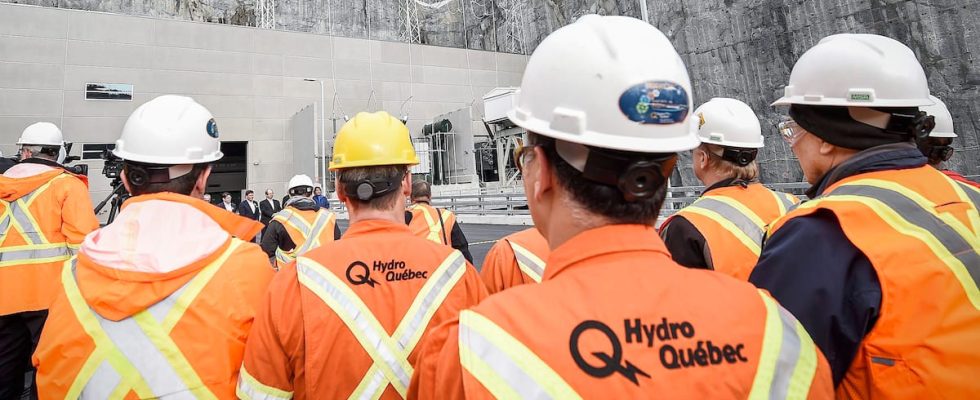In less than two years, Hydro-Québec went from a surplus of 40 TWh to needs of more than 100 TWh. But Hydro planners aren’t the only ones to blame. Successive CEOs also have their share of responsibility in this turnaround, according to experts.
• Read also: Electricity consumption: Mont-Saint-Anne reduces its opening hours
• Read also: The breach of the denationalization of Hydro-Québec
• Read also: [PHOTOS] Power outage in the Old Port: more than 2,000 customers affected
In a document filed with the energy board at the turn of 2020, Hydro-Québec still mentioned that “the production capacity of its power stations and its other sources of supply, however, exceeds its needs by more than 40 TWh per year. »
However, from November 2021, the state company announced the end of electricity surpluses and the launch of calls for tenders to purchase considerable quantities on the market.
March 2022: new CEO Sophie Brochu announces that Quebec will need an additional 100 terawatt hours (TWh) of energy if the province wants to achieve carbon neutrality by 2050, or nearly half of the company’s annual production. State.
Who was wrong?
“We must distinguish between Hydro-Québec employees who do planning and the company’s managers. Éric Martel (Editor’s note: Sophie Brochu’s predecessor), for example, had a short-term vision and wanted to monetize surplus energy, while Madame Brochu was someone more realistic who based herself on internal analyses. explains Gaétan Lafrance, specialist in energy planning and professor emeritus at the National Institute of Scientific Research.
This expert, who has participated in this type of planning for 40 years, points out that managers can sometimes receive the same information internally, but communicate the information differently depending on their vision.
“Mr. Martel, and even François Legault at the time, was against wind power, because they said that we had enough energy and that we did not need it. This was the message sent to both the government and Hydro-Québec. However, it was false. People like me who were internally did not agree at all,” says Mr. Lafrance.
- Listen to Yves Daoust’s economic segment via
:
The cryptocurrency boom
Everything started to change in 2018, explains Sylvain Audette, professor at HEC, with the windfall from data centers and cryptocurrency companies.
“They’ve been a little too successful in attracting these businesses. In one year, the demand for electricity for these sectors quadrupled and that’s when we started to worry and talk about it publicly, he explains.
But in 2019, the line of communication at Hydro-Québec was still to talk about surpluses of 40 TWh. “In my opinion, internally, there must have been clans who said: no, it doesn’t work.” Then Sophie Brochu arrived and the message changed, notes the professor.
A paradigm shift?
At Hydro, we are talking about a “total paradigm shift”, which happened quite quickly and which took everyone a bit by surprise,” spokesperson Maxence Huard-Lefebvre recently explained to the Journal. “What changes [c’est] that industrial players want to decarbonize. And the electricity networks too, especially those still powered by coal. We did not see this evolution in demand in our strategic plans before the arrival of Sophie Brochu,” he explains.
“We did not expect such strong economic growth post-pandemic,” notes François Bouffard, researcher at McGill University. “Also, the number of square feet of average housing built today in Quebec is much higher. One of the reasons which explains the disappearance of 40 terawatt hours is also residential demand which is constantly increasing,” he says.
The thread of events
June 2015 : Éric Martel appointed head of Hydro-Québec.
November 2018 : Hydro expects to have electricity surpluses until 2026.
January 2018 : Hydro-Québec wins the export contract to Massachusetts (9.45 terawatt-hours/year for 20 years).
November 2019 : a Hydro document filed with the Régie reaffirms the surplus of 40 TWh per year.
March 2020 : Éric Martel leaves Hydro-Québec for Bombardier.
April 2020 : Sophie Brochu replaces Éric Martel at Hydro-Québec.
November 2021 : Hydro’s supply plan highlights that the era of surpluses is over. Hydro-Québec is launching several calls for tenders to fill the supply gap expected by the end of 2026.
November 2021 : Hydro-Québec signs the export contract with New York (10.4 terawatt-hours/year for 25 years).
January 2022 : Hydro-Québec sends a letter to its industrial customers to warn them that certain projects will not be accepted automatically as in the past.
March 2022 : Hydro-Québec announces that Quebec needs 100 TWh to achieve carbon neutrality by 2050.
October 2022 : Minister Pierre Fitzgibbon affirms that Quebecers will have to comply with a form of “energy sobriety” in the coming years.
